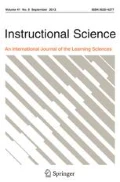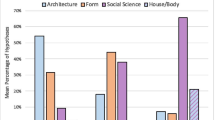Abstract
This paper reports a study of (1) students' responses to an anomaly generated by the juxtaposition of opposing explanatory frameworks and (2) the nature and impact of cognitive conflict as students move from pre-scientific to scientific explanatory frameworks concerning the concept of force. Both rational and emotional responses to anomaly were observed and student responses to anomaly were ranked according to the extent of disequilibrium generated. In addition, ways in which students resolve anomaly were recorded and processes associated with dissonance resolution and learning were hypothesized. Finally, the impact of dissonance was seen to influence students' epistemological beliefs about learning.
Similar content being viewed by others
References
Ausubel, D., Novak, J. & Hanesian, H. (1978).Educational Psychology: A Cognitive View. New York: Holt, Rinehart, and Winston.
Bell, A. (1987). Misconceptions, conflict and discussion in the teaching of graphical interpretations. In Proceedings of the Second International Seminar: Misconceptions and Educational Strategies in Science and Mathematics, Cornell University, Ithaca, N.Y.
Berlyne, D. (1965). Curiosity and education, in J.D. Krumboltz, ed.,Learning and the Educational. Process. Chicago: Rand McNally and Co.
Brna, P. (1987). Confronting dynamics misconceptions.Instructional Science 16: 351–379.
Champagne, A., Klopfer, L. & Gunstone, R. (1982). Cognitive research and the design of science instruction.Educational Psychology 17: 31–53.
Clement, J. (1982). Students' preconceptions in introductorymechanics. American Journal of Physics 50: 60–71.
Driver, R. (1973). The representation of conceptual frameworks in young adolescent science students. Unpublished doctorate thesis, University of Illinois.
Festinger, L. (1956).A Theory of Cognitive Dissonance. New York: Harper and Row.
Gilbert, J. & Watts, M. (1983). Misconceptions and alternative conceptions: Changing perspectives in science education.Studies in Science Education 10: 61–98.
Goetz, J. & LeCompte, M. (1981). Ethnographic research and the problem of data reduction.Anthropology and Education Quarterly 12: 51–70.
Gorsky, P. & Finegold, M. (1992). Using computer simulations to restructure students' conceptions of force.Journal of Computers in Mathematics and Science Teaching 11: 163–178.
Hewson, P. & Hewson, M. (1984). The role of conceptual conflict in conceptual change and the design of science instruction.Instructional Science 13: 1–13.
Kuhn, D. (1972). Mechanisms of change in the development of cognitive structure.Child Development 43: 823.
Nussbaum, J. & Novick, S. (1982). Alternative frameworks, conceptual conflict, and accommodation: Toward a principled teaching strategy.Instructional Science 11: 183–200.
Osborne, R. & Freyberg, P. (1985).Learning in Science: The Implication of Children's Science. Auckland: Heinemann.
Posner, G., Strike, K., Hewson, P. & Gertzoy, W. (1982). Accommodation of scientific conception: Toward a theory of conceptual change.Science Education 66: 211–227.
Stavy, R. & Berkovitz, B. (1980). Cognitive conflict as a basis for teaching quantitative aspects of the concept of temperature.Science Education 64: 678–692.
Wallas, G. (1921).The Art of Thought. New York: Harcourt, Brace and World.
Zietsman, A. & Hewson, P. (1986). The effect of instruction using microcomputer simulations.Journal of Research in Science Teaching 23: 27–39.
Author information
Authors and Affiliations
Rights and permissions
About this article
Cite this article
Gorsky, P., Finegold, M. The role of anomaly and of cognitive dissonance in restructuring students' concepts of force. Instr Sci 22, 75–90 (1994). https://doi.org/10.1007/BF00892158
Accepted:
Issue Date:
DOI: https://doi.org/10.1007/BF00892158




